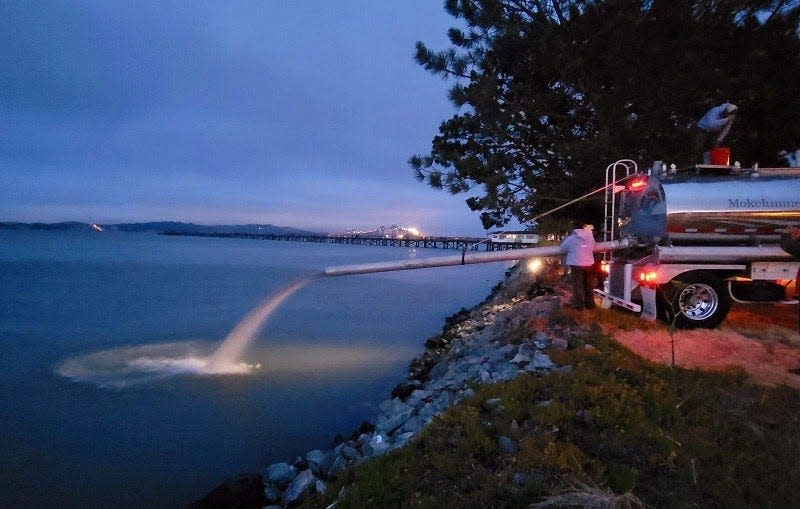CDFW releases 23 million juvenile fall-run Chinook salmon in rivers and bays
As the salmon fishing closure continues on California’s ocean waters and rivers, the California Department of Fish and Wildlife (CDFW) announced that it has completed the release of approximately 23 million juvenile fall-run Chinook salmon raised at its four Central Valley anadromous fish hatcheries.
These facilities include the Feather River Fish Hatchery, the Nimbus Fish Hatchery on the American River, the Mokelumne River Fish Hatchery and the Merced River Hatchery.
The 23 million salmon raised and released by CDFW in 2023 is a 15% increase over the roughly 20 million fall-run Chinook salmon raised and released in 2022.

10.4 million of these fish are from the Feather River Hatchery, 5.6 million are from Nimbus Fish Hatchery and 7.0 million are from the Mokelumne River Fish Hatchery.
“This year’s production goals were increased as a coordinated effort among state and federal partnering agencies to help fall-run Chinook salmon overcome impacts from an extended drought that increased water temperatures and decreased water flow throughout the Central Valley during critical salmon spawning and rearing periods,” the CDFW stated in a press statement.
Beyond the hatchery production increase, CDFW said it “carried out several new, innovative and experimental release strategies to take advantage of some of the best in-river flows and water conditions in years and to increase overall survival.”
For the first time since 2020, CDFW conducted in-river salmon releases within the Feather River and the American River to take advantage of the increased water flows associated with winter storms that continued into the spring.
“These flows increased available rearing habitat and provided for increased survival while migrating toward the ocean,” the CDFW said. “Salmon smolts outfitted with acoustic tags were released with larger groups in their natal rivers to allow CDFW to monitor and track their downstream migration to the ocean.”
The Department said that preliminary results suggest “high survival” for groups of hatchery-raised fish released into the river systems in 2023.
“The more than one million salmon fry released into the American River in February represented CDFW’s initial effort with ‘Parentage Based Tagging’ or PBT. These juvenile salmon don’t carry physical markings or tags, but their genetic signatures have been recorded and stored for future analysis to evaluate the overall success of the fry release,” the CDFW noted.
The Feather River Fish Hatchery released smaller juvenile fall-run Chinook salmon earlier in the spring than the typical smolt releases to diversify “hatchery release strategies as well as the timing and size of hatchery-raised fish entering into the bay and marine environments,” the Department added.
CDFW said it also increased the number of release sites and strategies used within San Francisco and San Pablo bays. These included new release locations at the Estuary and Ocean Science Center in partnership with San Francisco State University; Point San Quentin, in partnership with the Marin Rod and Gun Club; and Brickyard Cove in Richmond in partnership with the City of Richmond and the Golden Gate Salmon Association.
“At these locations, smolts were released at night on strong outgoing tides to reduce bird predation and encourage seaward migration,” the CDFW said.
In addition, 162,000 Central Valley fall-run salmon were released into Monterey Harbor, 160,000 into Santa Cruz Harbor in Monterey Bay and 752,000 into Pillar Point Harbor in Half Moon Bay.
Twenty-five percent of all fall-run Chinook salmon raised and released by CDFW’s Central Valley anadromous fish hatcheries, with the exception of PBT release groups in the American River, carry coded-wire tags (CWT). These tags have information on their origin and the fish have a clipped adipose fin to indicate their hatchery origin, according to the CDFW.
“Both CWT and PBT tagged fish will provide important scientific data that will inform future management decisions and hatchery operations,” the agency noted.
The Sacramento and Klamath River systems support the bulk of California’s commercial and recreational ocean salmon fisheries when the seasons are open. The CDFW said the salmon fishing seasons will be reevaluated in 2024.
The CDFW blamed “drought conditions coupled with Thiamine Deficiency Complex, a vitamin deficiency that impacts reproduction, for the reduction in in-river spawning success the past several years.”
While these factors certainly contributed to the salmon decline, anglers, Tribal leaders and environmentalists also point to the failure of the state and federal governments to maintain a cold water pool in upstream Central Valley reservoirs so that cold water could be released for salmon during the drought.
“The bottom line for salmon eggs and juvenile salmon in the 2020-2021 seasons was a series of decisions that dramatically worsened flow and temperature conditions during the drought,” said Scott Artis, executive director of Golden State Salmon Association (GSSA). “This resulted in catastrophic losses in juvenile salmon in the 2020 and 2021 year classes.”
“Thiamine definitely played a role in this decline, but brushing off the impacts of poor temperature and flow conditions in our salmon rivers is simply engaging in PT Barnum style-showmanship as the Newsom Administration has us looking at the waving hand of drought while their other hand is neatly tucked into the water policy pocket- diverting our attention and our critical water resources that people, the ecosystem and salmon need. Newsom is the greatest water showman and I’m waiting for him to unveil the next Fiji mermaid of salmon,” he argued.
In addition, the overharvest of salmon in ocean fisheries over the past few years because of a flawed model for forecasting ocean salmon abundance used by the National Marine Fisheries Service and Pacific Fishery Management Council (PFMC) also played a role in the collapse, according to anglers.
Last year federal fishery managers estimated that more than 180,000 fall-run salmon would return to spawn, based on the controversial ocean salmon abundance forecasting model, but less than 62,000 actually returned to the Sacramento River and tributaries.
This article originally appeared on Visalia Times-Delta: CDFW releases 23 million juvenile fall-run Chinook salmon

